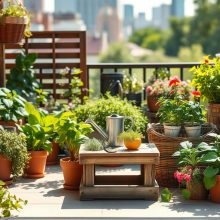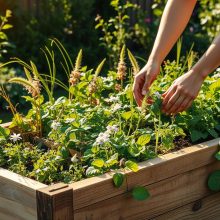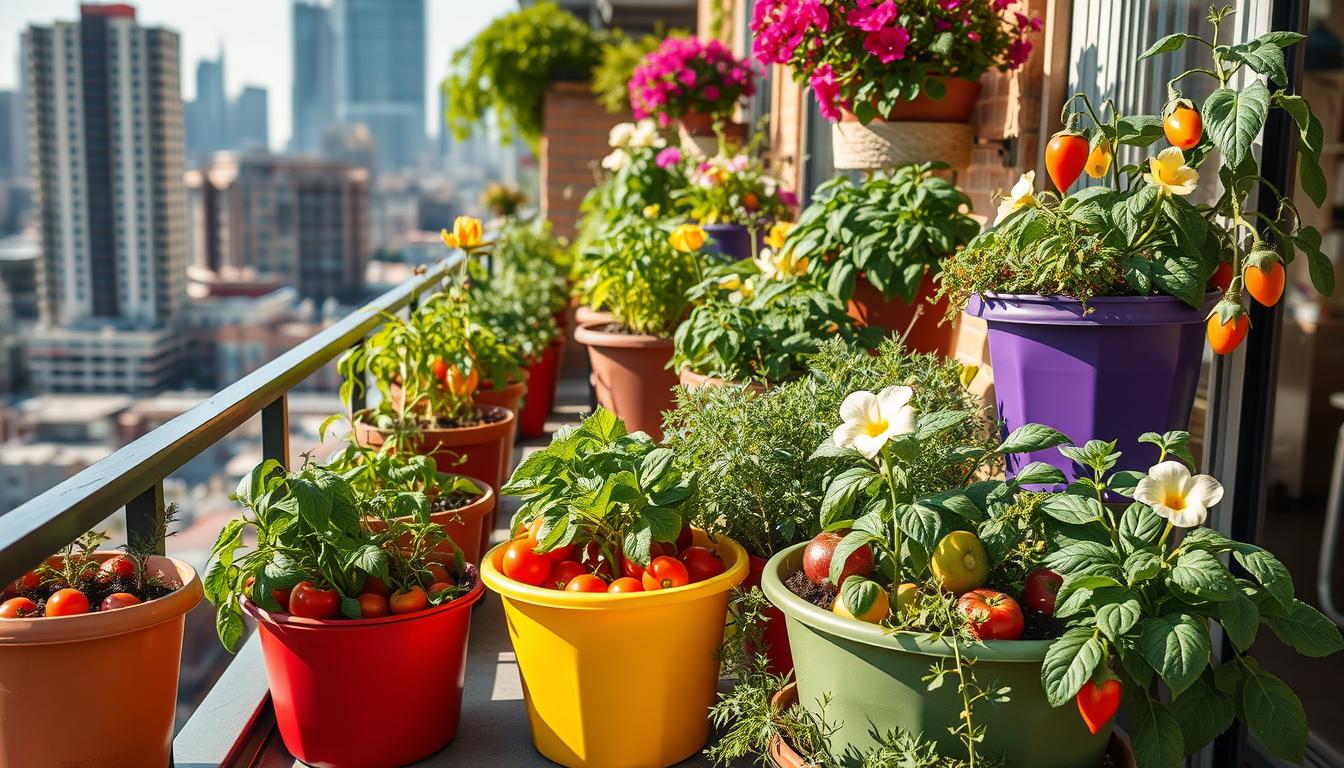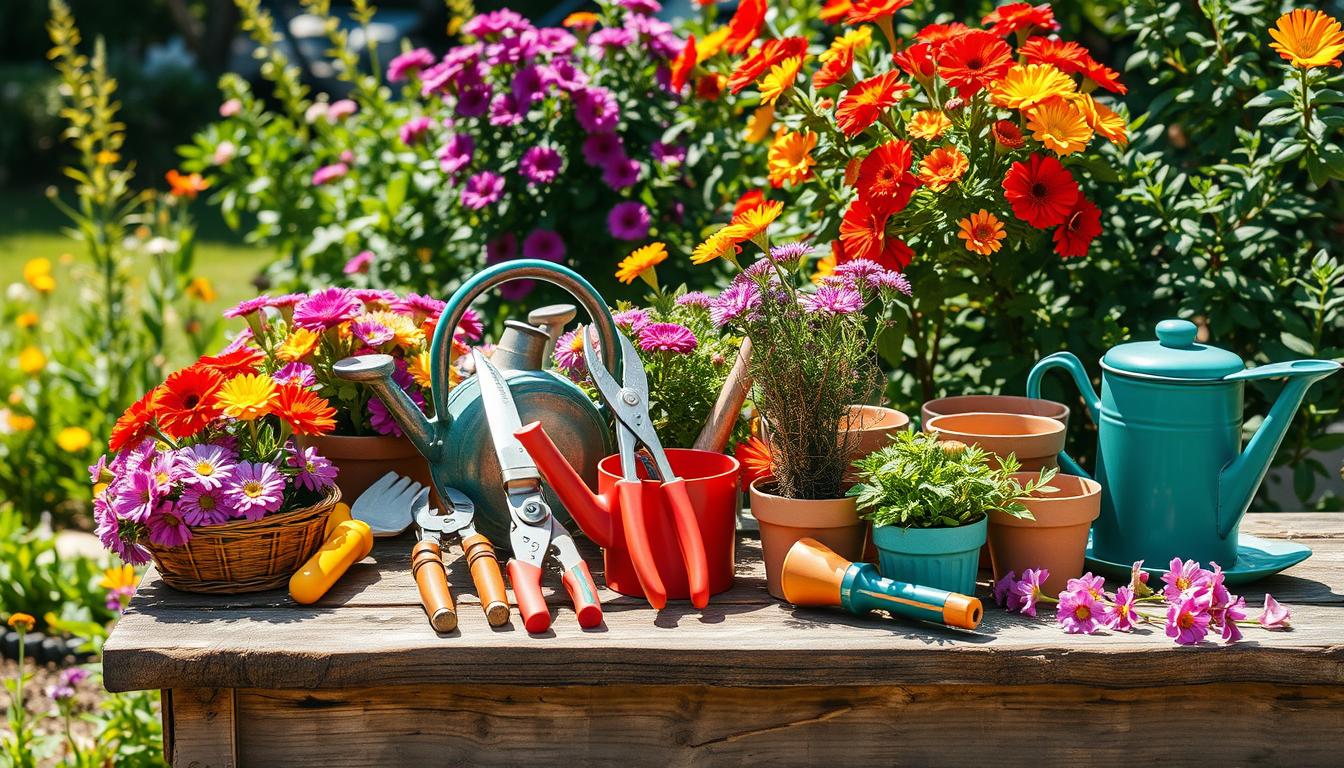Container Gardening: Essential Tips for Urban Spaces
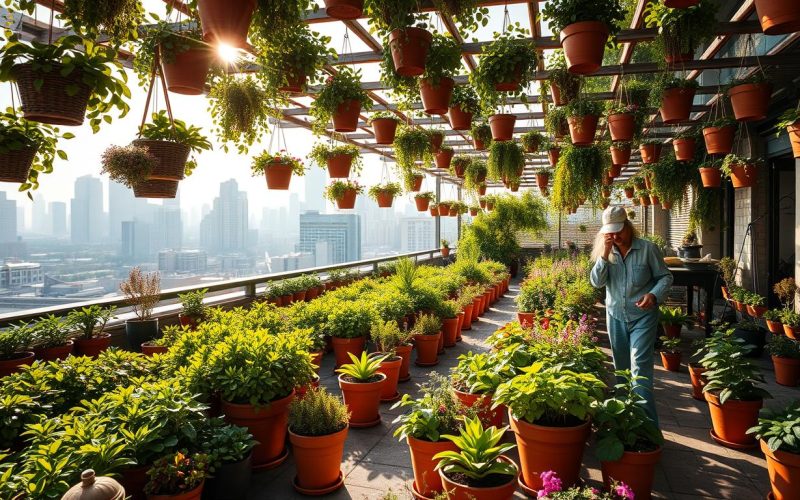
Living in the city doesn’t mean you can’t have green spaces. Container gardening is a game-changer for city folks wanting to turn small areas into lush gardens. It’s a big hit for indoor gardening, letting people grow plants on balconies, window sills, and tiny urban spots.
Traditional gardening can be tough in the city. But container gardening is a smart way to grow plants in small spaces. It’s perfect for small apartments or tiny balconies, helping you create a green oasis that improves your living space and mood.
Container gardening is all about flexibility and ease. City folks can grow herbs, veggies, and even decorative plants, no matter where they live. With the right tips, anyone can have a thriving indoor garden that brings nature right into their home.
Key Takeaways
- Container gardening maximizes limited urban living spaces
- No outdoor garden required for successful plant cultivation
- Versatile approach works for apartments, balconies, and small homes
- Provides mental health benefits through connection with nature
- Accessible gardening method for beginners and experienced plant enthusiasts
Understanding Indoor Gardening Concepts
Indoor gardening turns homes into green havens. It lets city folks grow gardens indoors, even without outdoor space. This is a new way to care for plants.
It’s more than just adding plants to your home. It’s about making a healthy, green space. This connects us to nature in our own homes.
Definition of Indoor Gardening
Indoor gardening means growing plants inside using special methods. This includes:
- Growing plants in pots
- Using light from lamps or windows
- Keeping the right temperature and humidity
- Using special ways to care for plants
Benefits of Indoor Gardening
Indoor gardening has many benefits for city folks:
- It makes the air cleaner
- It lowers stress and boosts mood
- You can have fresh herbs and veggies all year
- It makes your home look better
Common Misconceptions
Some think indoor gardening is hard or only for experts. But, anyone can do it with a little knowledge and care. Start small, learn as you go, and watch your garden grow.
Choosing the Right Containers
Container gardening turns city spaces into lively green spots. Picking the right containers is key for growing plants indoors. The right container supports plant growth, matches your home’s look, and helps your plants do well.
When looking at container gardening options, think about these important points:
- Material durability
- Size needs for different plants
- Drainage abilities
- Looks
Types of Containers for Indoor Gardening
Urban gardeners have many container choices for indoor plants. Ceramic pots add a classic touch, while plastic ones are light and easy to move. Terracotta containers are great for plants that need good air and water balance.
Considerations for Drainage
Good drainage stops root rot and helps plants grow well. Look for containers with holes for water to drain. The right potting mix works best in containers that let water out, keeping roots dry.
Aesthetic and Functional Options
Modern container gardening mixes looks with function. You can find sleek metal planters, recycled wooden boxes, and hanging baskets. Choose containers that fit your home’s style and meet your plants’ needs.
- Hanging planters for vertical spots
- Window boxes for herbs
- Modular containers for easy changes
Choosing the right containers is the first step to a successful indoor garden. Your choices affect plant health, growth, and your garden’s look.
Selecting Suitable Plants
Indoor gardening lets city folks grow their own plants. It turns small spaces into green havens, even with little room and light.
Starting a garden indoors means knowing your space and picking plants that will do well there. It’s all about matching what plants need with what your home offers.
Best Indoor Plants for Beginners
Beginners should pick plants that can handle a little forgetfulness. Here are some great choices:
- Snake plants (extremely low-maintenance)
- Pothos (adaptable to various light conditions)
- Spider plants (quick-growing and forgiving)
- Peace lilies (excellent air purifiers)
Low-Light Plants for Urban Environments
Many city homes get little natural light. But, some plants do great in low light. Seed starting is easier with these:
- Chinese evergreen
- ZZ plant
- Philodendron
- Dracaena
Herbs and Vegetables for Container Gardening
Container gardening is perfect for growing your own food indoors. Here are some great choices:
- Cherry tomatoes
- Green beans
- Leafy greens
- Herbs like basil, mint, and chives
When picking plants for indoor gardening, think about light, temperature, humidity, and how much care you can give. Start small, try new things, and enjoy making your indoor garden.
Soil and Nutrient Requirements
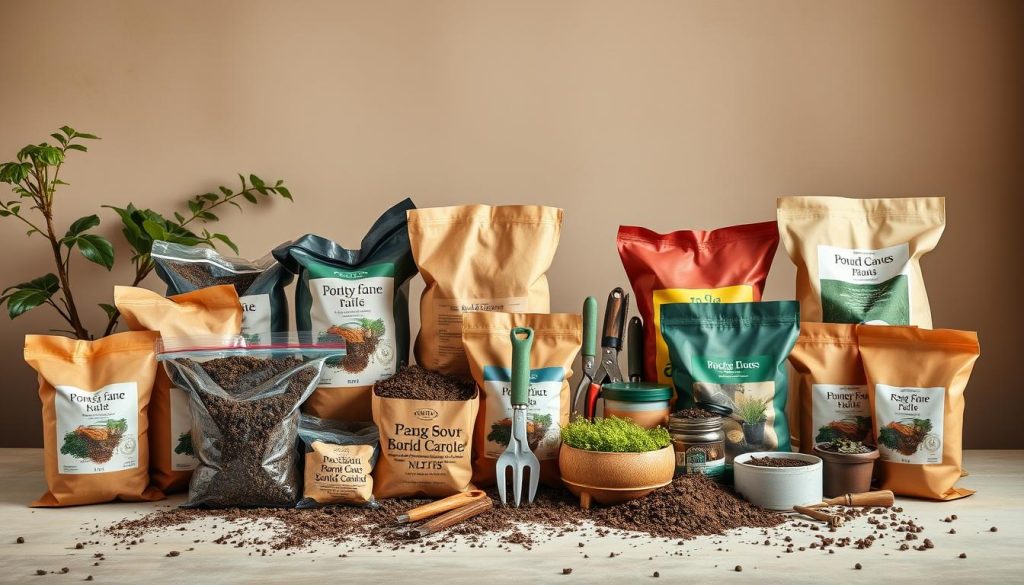
Starting a container garden means understanding soil quality is key. Potting mixes are vital for plant growth, giving plants the nutrients they need. Gardeners must choose and care for high-quality soil for strong plant health.
Importance of Quality Soil
Soil quality varies greatly. Container gardens need special potting mixes. These mixes should have:
- Excellent drainage
- Proper nutrient retention
- Optimal air circulation
- Balanced pH levels
Nutrient-Rich Additives
Adding organic supplements to your potting mixes can greatly help plant health. Here are some good options:
- Compost
- Worm castings
- Bone meal
- Aged manure
Seasonal Soil Maintenance
Plant care means watching soil conditions closely. Regularly test and add nutrients to keep your gardens healthy all year. Check soil type seasonally and adjust mixes for each plant’s needs.
Healthy soil is crucial for urban gardeners. Focus on soil quality and upkeep to help plants thrive.
Light Requirements for Indoor Gardens
Success in indoor gardening starts with knowing about light. Plants need certain light conditions to grow well. Understanding this is key to a healthy indoor garden.
Natural vs. Artificial Lighting Strategies
Sunlight is best for plants, but grow lights are good alternatives indoors. Each plant has its own light needs:
- Fruiting vegetables need 6-8 hours of full sunlight
- Leafy greens tolerate lower light conditions
- Succulents prefer bright, indirect illumination
Measuring Light Levels Effectively
Measuring light accurately helps gardeners place plants right. Simple tools like light meters are useful. Most plants need 250-1000 foot-candles of light to grow well.
Optimal Plant Positioning Techniques
Placing plants wisely is key to getting enough light indoors. South-facing windows give the most natural light. When this isn’t enough, grow lights help plants grow.
- Place plants near windows with filtered sunlight
- Rotate plants regularly for even light distribution
- Use reflective surfaces to enhance light exposure
Choosing the right grow lights ensures your garden gets the light it needs. This is true for all seasons and indoor spaces.
Watering Techniques for Container Gardens
Learning to water your container garden is key. City gardeners often find it hard to keep the right moisture. It’s important for your plants to grow well and avoid damage.
Every plant is different and needs the right amount of water. This depends on the plant’s type, size, and where it’s placed.
Identifying Watering Stress Signals
Plants show signs when they need water. Look out for these:
- Overwatering signs:
- Yellowing leaves
- Soft, mushy stem bases
- Fungus or mold on soil surface
- Underwatering signs:
- Crispy, brown leaf edges
- Drooping or wilting plants
- Dry, cracked soil
Creating Effective Watering Schedules
Having a regular watering plan is crucial. Think about these things when setting your schedule:
- What kind of plant you have and how much water it needs
- The size and material of your container
- Changes in temperature with the seasons
- How humid it is where you live
Essential Watering Tools
Get tools that make caring for your plants easier. Tools like moisture meters, self-watering pots, and drip irrigation systems help keep your plants hydrated.
With these watering tips, you can make your container garden flourish. It will add life and beauty to your city space.
Pest Management in Indoor Gardens
Indoor gardening brings joy, but pest control can be tough. It’s key to keep your plants healthy by fighting pests.
Starting with pest control means knowing common pests. Spotting and fixing these issues can save your plants.
Common Indoor Garden Pests
- Aphids: Tiny insects that cluster on plant stems and leaves
- Spider mites: Microscopic pests that create webbing on plants
- Fungus gnats: Small flying insects that indicate overwatered soil
- Mealybugs: White, cottony insects that feed on plant sap
Organic Pest Control Methods
Controlling pests indoors doesn’t need harsh chemicals. Natural methods can keep your plants safe and healthy.
- Neem oil: A powerful natural insecticide
- Insecticidal soap: Gentle yet effective pest treatment
- Companion planting with pest-repelling herbs
- Introducing beneficial insects like ladybugs
Preventive Measures
Stopping pests before they start is key. Keeping an eye on your plants and their health helps a lot.
- Inspect plants weekly for early signs of pest activity
- Maintain proper plant spacing
- Use clean, sterilized potting soil
- Avoid overwatering plants
- Quarantine new plants before introducing them to your indoor garden
With these steps, your indoor garden can stay healthy and lively all year.
Creating a Suitable Indoor Environment
Indoor gardening needs careful attention to the environment. The right mix of temperature, humidity, and air flow makes your garden thrive.
Temperature and Humidity Essentials
Most plants do best in certain temperatures. The ideal range is 60-75°F (15-24°C), close to their natural habitats. Keeping an eye on these conditions helps prevent stress and damage.
- Maintain consistent temperatures
- Avoid drafts and sudden temperature changes
- Use digital thermometers for accurate tracking
Air Circulation and Moisture Management
Good air movement is key in indoor gardening. Fans help prevent fungal growth and strengthen stems. Humidity levels of 40-60% are best for most houseplants.
- Use small oscillating fans
- Place fans to promote gentle air movement
- Consider humidity trays for moisture-loving plants
Seasonal Adaptation Strategies
Indoor gardens need different care with the seasons. Winter means less light and drier air, while summer brings heat and moisture challenges. Adjusting your care ensures success all year.
- Adjust watering frequency seasonally
- Relocate plants based on changing light conditions
- Use supplemental grow lights during darker months
Vertical Gardening Solutions
Urban dwellers are finding magic in vertical gardens for small spaces. Container gardening now includes vertical methods. These methods turn tiny areas into green oases. They let garden lovers grow more without losing space.
Vertical gardens are great for city gardeners. They save space and make beautiful displays. These displays can brighten up both inside and outside spaces.
Key Benefits of Vertical Gardening
- Maximizes limited space in urban apartments
- Improves air quality and indoor aesthetics
- Reduces environmental stress on plants
- Creates natural insulation for buildings
Popular Vertical Gardening Structures
Container gardening now includes many vertical systems. Gardeners can pick from:
- Wall-mounted planter systems
- Hanging basket arrangements
- Modular living wall installations
- Trellis and climbing plant supports
DIY Vertical Garden Ideas
Building a vertical garden is easy. You can use wooden pallets, hanging shoe organizers, and recycled containers. The trick is knowing what plants need and picking the right setup for them.
Start small with vertical gardens for windowsills or balconies. With a little creativity and gardening know-how, anyone can create a lush vertical garden. It brings nature right into your home.
Incorporating Hydroponics into Indoor Gardening
Hydroponic systems change indoor gardening. They let city gardeners grow plants without soil. This method is perfect for small spaces, like apartments and homes.
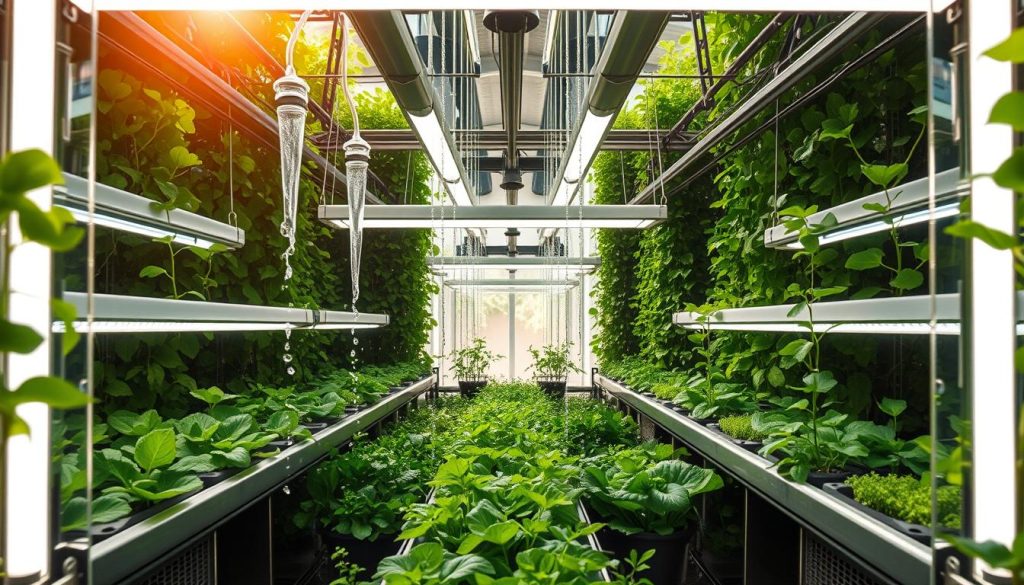
Hydroponics open new doors for indoor garden lovers. They use water solutions instead of soil. This makes growing plants efficient and controlled.
Basic Hydroponic Systems to Know
- Deep Water Culture (DWC)
- Nutrient Film Technique (NFT)
- Ebb and Flow Systems
- Drip Irrigation Hydroponics
- Vertical Hydroponic Towers
Benefits of Hydroponic Gardening
Hydroponic gardening has many benefits:
- Faster plant growth rates
- Water conservation
- Reduced pest problems
- Year-round growing capabilities
- Space-efficient cultivation
Plants Perfect for Hydroponics
Some plants do great in hydroponics. Leafy greens like lettuce and spinach are perfect. Herbs like basil and mint grow fast too. Even cherry tomatoes and strawberries can thrive.
Start with easy plants for beginners. As you get better, add more to your garden. With the right care, hydroponics can make your indoor gardening amazing.
Combining Indoor Gardening with Decor
Container gardening turns city homes into lively, green spaces. It mixes usefulness with beauty. Indoor gardening lets you make amazing views and bring nature into your home.
To make an urban oasis, plan where to put plants and how to match containers with your decor. Good indoor gardening is more than just growing plants. It’s about making a peaceful living space.
Creating a Stylish Plant Display
- Select containers that complement your interior color scheme
- Use varying heights and textures for visual interest
- Consider plant sizes relative to available space
- Match container materials with room aesthetics
Design Tips for Plant Placement
Placing plants wisely adds beauty and function to indoor gardening. Put big plants in living areas as highlights. Smaller gardens fit well on windowsills, shelves, and kitchen counters.
Integrating Containers with Home Design
Modern design loves container gardening as a key feature. Pick sleek planters for modern homes or rustic pots for traditional ones. The goal is to blend plants smoothly with your decor.
Smart Technology in Indoor Gardening
Technology has changed plant care, making indoor gardening easier and smarter. Now, gardeners can use advanced tech to manage grow lights and care for plants with great precision.
Smart garden monitoring systems are a big deal for indoor plant lovers. They give real-time info on important things like soil moisture and temperature. This info helps plants grow better.
Benefits of Garden Monitoring Systems
- Tracks soil moisture levels accurately
- Monitors ambient temperature and humidity
- Provides immediate alerts for plant stress signals
- Enables remote plant care management
Smart Lighting and Irrigation Solutions
New grow lights have smart features. They can change light spectrum and intensity on their own. This helps plants grow well, even when you’re not around.
Apps for Garden Planning and Care
Smartphone apps make plant care easy. They offer tools to identify plants, send care reminders, and track your garden’s progress. It’s all done with a few taps.
- Plant identification databases
- Personalized care schedules
- Nutrient and watering recommendations
- Community gardening forums
Smart tech helps indoor gardeners care for plants better with less work. These tools make growing plants indoors fun and easy.
Troubleshooting Common Indoor Gardening Issues
Indoor gardening comes with its own set of challenges. To care for your plants well, you need to watch them closely and solve problems quickly. Spotting early signs of stress and fixing them can keep your garden healthy.
Identifying Plant Stress Signals
Plants show their health through signs. Look out for these important signals:
- Yellowing leaves
- Wilting or drooping
- Stunted growth
- Discolored or spotted foliage
Adapting to Seasonal Changes
Seasons change how you care for your plants indoors. Keep an eye on temperature, humidity, and light. In winter, water less and add more humidity. In summer, water more often and watch for pests.
Resources for Plant Health Support
Learn more about plant care from trusted sources:
- Local botanical gardens
- Online gardening forums
- Professional horticulture consultants
- Specialized plant care workshops
Keeping your indoor garden healthy takes time, patience, and learning. By knowing the challenges and using pest control, you can have a lively and strong indoor garden.
Expanding Your Gardening Skills and Knowledge
Indoor gardening and container gardening are always evolving. They need constant learning and a deep love for gardening. As you grow, connecting with others in your community is key. It helps you learn and stay inspired.
Digital spaces are great for gardeners to meet and learn. Sites like Reddit’s r/IndoorGardening and Facebook groups are perfect. They let gardeners share, solve problems, and share new ideas. This way, everyone can grow their gardening knowledge.
Exploring Learning Opportunities
Local gardens, community centers, and extension offices often have workshops. These hands-on classes teach a lot about indoor gardening. You can learn from experts and get tips that online resources can’t offer.
Recommended Resources
For those wanting to dive deeper, there are many resources. Magazines like Urban Farm and Modern Farmer share the latest in indoor gardening. Books like “The New Urban Garden” by Michael Lavelle and Epic Gardening’s website are full of useful tips. They help you improve your container gardening skills.
